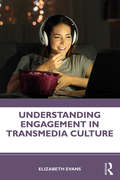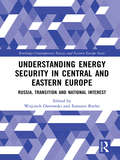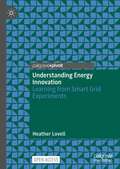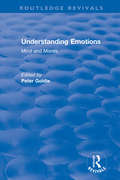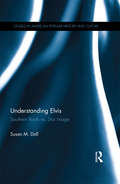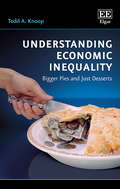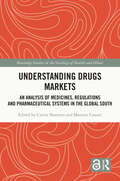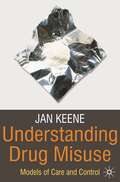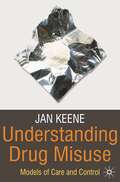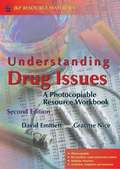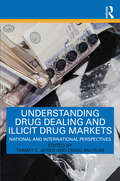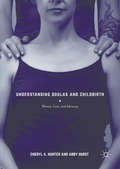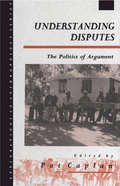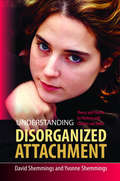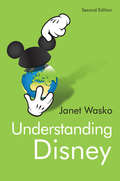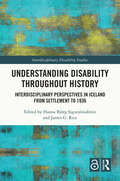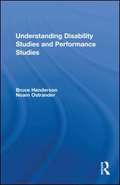- Table View
- List View
Understanding Engagement in Transmedia Culture
by Elizabeth EvansThis book offers a new, interdisciplinary model for understanding audience engagement as a type of behaviour, a form of response and a cost to audiences that, combined, offer value to the screen industries. Audience ‘engagement’ has become the key priority of the screen industries. Understanding Engagement in Transmedia Culture explicitly asks what audiences and screen practitioners mean when they say content is ‘engaging’ and uses audience focus groups and practitioner interviews to offer a model for understanding the relationship between the screen industry, the content it produces and its audiences. In particular, the model addresses engagement within transmedia culture. As digital screen technologies proliferate, audiences move seamlessly across and between different devices, content formats and distribution platforms, blurring the boundaries between film, television and videogames. This book offers a way of understanding audience engagement that is not restricted to a single media but instead accounts for and adapts to the various ways in which screen content is experienced. Offering a unique approach by presenting practitioner and audience perspectives, it is perfect for students and scholars working in film and television studies, as well as media industries and audience studies.
Understanding Energy Security in Central and Eastern Europe: Russia, Transition and National Interest (Routledge Contemporary Russia and Eastern Europe Series)
by Wojciech Ostrowski Eamonn ButlerThe purpose of this book is to move beyond the approach which views energy as a purely geopolitical tool of the Russian state and assumes a 'one size fits all' approach to energy security in Central and Eastern Europe (CEE). It argues that in order to fully understand Russian involvement in the regional energy complex, the CEE-Russian energy relationship should be analysed in the context of the political and economic transitions that Russia and the CEE states underwent. The chapters on individual countries in the book demonstrate that, although Russia has and will continue to play a substantial role in the CEE energy sector, the scope of its possible influence has been overstated.
Understanding Energy Security in Central and Eastern Europe: Russia, Transition and National Interest (Routledge Contemporary Russia and Eastern Europe Series)
by Wojciech Ostrowski Eamonn ButlerThe purpose of this book is to move beyond the approach which views energy as a purely geopolitical tool of the Russian state and assumes a 'one size fits all' approach to energy security in Central and Eastern Europe (CEE). It argues that in order to fully understand Russian involvement in the regional energy complex, the CEE-Russian energy relationship should be analysed in the context of the political and economic transitions that Russia and the CEE states underwent. The chapters on individual countries in the book demonstrate that, although Russia has and will continue to play a substantial role in the CEE energy sector, the scope of its possible influence has been overstated.
Understanding Energy Innovation: Learning from Smart Grid Experiments
by Heather LovellThis open access book uses smart grids to explore and better understand energy innovation, from a social science perspective. Understanding Energy Innovation has four core themes—networks, nodes, narratives and nostalgia—and each chapter tackles a theme, using case studies from Australia and Europe. Energy innovation is currently occurring at a rapid pace, in response to a host of problems including climate change, high energy prices, and unreliable supply. Understanding Energy Innovation provides ways to think about and plan for energy sector reform and innovation, drawing on core ideas from social and innovation theory, and centred on smart grids as a case study. These academic ideas are written about in an accessible way, recognising that a diversity of people have an interest in energy innovation generally, and smart grids more specifically, and would like to find out more about ways of understanding energy innovation that integrate the social and the political.
Understanding Emotions: Mind and Morals (Routledge Revivals)
by Peter GoldieThis title was first published in 2002: At the end of the 20th century, the emotions ceased to be a neglected topic for philosophical consideration. The editor suggests that this may, in part, be due to a change in the way the subject is approached. The emotions were characteristically thought of by philosophers as states which give rise to perturbation in what might roughly be called "right-thinking". The basic idea was that practical reasoning, like theoretical reasoning, ought to be, and can be, dispassionate. This means that either the emotions interfere with "right-reasoning" in a way which is a proper object of study for the biological sciences but not for the science of the mind, or that the emotions become reducible to, and analyzable as, collections of propositional attitudes which are themselves assessable in terms of "right-reasoning". The move away from this idea is taken as an improvement in our philosophical approach to the emotions by the authors. Following this, all of the papers in the volume contribute to this philosophical approach, each approaching the subject from a different angle.
Understanding Emotions: Mind and Morals (Routledge Revivals)
by Peter GoldieThis title was first published in 2002: At the end of the 20th century, the emotions ceased to be a neglected topic for philosophical consideration. The editor suggests that this may, in part, be due to a change in the way the subject is approached. The emotions were characteristically thought of by philosophers as states which give rise to perturbation in what might roughly be called "right-thinking". The basic idea was that practical reasoning, like theoretical reasoning, ought to be, and can be, dispassionate. This means that either the emotions interfere with "right-reasoning" in a way which is a proper object of study for the biological sciences but not for the science of the mind, or that the emotions become reducible to, and analyzable as, collections of propositional attitudes which are themselves assessable in terms of "right-reasoning". The move away from this idea is taken as an improvement in our philosophical approach to the emotions by the authors. Following this, all of the papers in the volume contribute to this philosophical approach, each approaching the subject from a different angle.
Understanding Elvis: Southern Roots vs. Star Image (500 Tips)
by Susan M. DollAlthough the importance of Elvis Presley's Southern heritage has long been recognized, few have considered the complex connection between the performer's career and his Southern roots. This study investigates how that identity affected each stage of Presley's career. Elvis Presley's career can be divided into three phases, each of which is signified by a specific image. Each image is coded by a certain style of music, mode of dress, and arena of performance. The evolution from one career phase to another was instigated by a specific event and represented a deliberate calculation on the part of Presley's manager to attract a wider audience. The first stage spans the years 1956 through 1958, after the singer was introduced to a national audience and before he was drafted into the army. His image as a notorious rock 'n' roller created a national controversy and was spurred by negative depictions of Presley in the media-many attributing his controversial performing style and appearance to his Southern background. His music was a fusion of rhythm and blues and country-western; or, two types of music indigenous to the South and foreign to the mainstream entertainment industry based in New York City. The second phase of Elvis' career included his stint as a movie star, in which most aspects of his Southern identity were extracted from his leading man image to enhance his appeal to the mainstream. And, finally, the last stage of his career focused on his image as a Las Vegas performer. Despite the gaudy costumes, Elvis reconnected to his identity as a Southerner in the 1970s by returning to country music and songwriters as a source of inspiration.
Understanding Elvis: Southern Roots vs. Star Image (500 Tips)
by Susan M. DollAlthough the importance of Elvis Presley's Southern heritage has long been recognized, few have considered the complex connection between the performer's career and his Southern roots. This study investigates how that identity affected each stage of Presley's career. Elvis Presley's career can be divided into three phases, each of which is signified by a specific image. Each image is coded by a certain style of music, mode of dress, and arena of performance. The evolution from one career phase to another was instigated by a specific event and represented a deliberate calculation on the part of Presley's manager to attract a wider audience. The first stage spans the years 1956 through 1958, after the singer was introduced to a national audience and before he was drafted into the army. His image as a notorious rock 'n' roller created a national controversy and was spurred by negative depictions of Presley in the media-many attributing his controversial performing style and appearance to his Southern background. His music was a fusion of rhythm and blues and country-western; or, two types of music indigenous to the South and foreign to the mainstream entertainment industry based in New York City. The second phase of Elvis' career included his stint as a movie star, in which most aspects of his Southern identity were extracted from his leading man image to enhance his appeal to the mainstream. And, finally, the last stage of his career focused on his image as a Las Vegas performer. Despite the gaudy costumes, Elvis reconnected to his identity as a Southerner in the 1970s by returning to country music and songwriters as a source of inspiration.
Understanding Economic Inequality: Bigger Pies and Just Desserts
by Todd A. KnoopOver the last 25 years, nearly two billion people across the globe have risen out of poverty and income levels have risen worldwide. Yet in the US, the top 1% earn twice the amount of income as the poorest 50% of the population. In the midst of rising prosperity, economic dissatisfaction—driven by the persistent fear felt by many that they are “falling behind”—is higher than at any point since the 1930s. In Understanding Economic Inequality, the author brings an economist’s perspective informed by new, groundbreaking research on inequality from philosophy, sociology, psychology, and political science and presents it in a form that it is accessible to those who want to understand our world, our society, our politics, our paychecks, and our neighbors’ paychecks better. As any history of the 21st century would be incomplete without understanding “the 99% versus the 1%”, the insights provided by the author will prove valuable to any reader. This book also provides the foundation for undergraduate courses on wealth and income inequality, and an essential reading for introductory economics, labor economics, public policy, law, or sociology courses.
Understanding Drugs Markets: An Analysis of Medicines, Regulations and Pharmaceutical Systems in the Global South
by Carine BaxerresDrawing on anthropology, historical sociology and social-epidemiology, this multidisciplinary book investigates how pharmaceuticals are produced, distributed, prescribed, (and) consumed, and regulated in order to construct a comprehensive understanding of the issues that drive (medicine) pharmaceutical markets in the Global South today. Based on primary research conducted in Benin and Ghana, and additional data collected in Cambodia and the Ivory Coast, this volume uses artemisinin-based combination therapies (ACTs) against malaria as a central case study. It highlights the influence of the countries colonial and post-colonial history on their models for state regulation, production, and distribution, explores the determining role transnational actors as well as industries from the North but also and increasingly from the South play in influencing local pharmaceutical markets and looks at the behaviour of health care professionals and individuals. Stepping back, the authors then unpick the pharmaceuticalization process and the multiple regulations at stake by looking at the workings of, and linkages between, (biomedical health) pharmaceutical systems, (representatives of companies) industries, actors in private distribution, and consumer practices. Providing a thorough comparative analysis of the advantages and disadvantages of different pharmaceutical systems, it is an important contribution to the literature on pharmaceutalization and the governance of medication. It is of interest to students, researchers and policy-makers interested in medical anthropology, the sociology of health and illness, global health, healthcare management and pharmacy. The Open Access version of this book, available at http://www.taylorfrancis.com/books/9780429329517, has been made available under a Creative Commons Attribution-Non Commercial-No Derivatives 4.0 license.
Understanding Drugs Markets: An Analysis of Medicines, Regulations and Pharmaceutical Systems in the Global South
by Carine Baxerres Maurice CassierDrawing on anthropology, historical sociology and social-epidemiology, this multidisciplinary book investigates how pharmaceuticals are produced, distributed, prescribed, (and) consumed, and regulated in order to construct a comprehensive understanding of the issues that drive (medicine) pharmaceutical markets in the Global South today. Based on primary research conducted in Benin and Ghana, and additional data collected in Cambodia and the Ivory Coast, this volume uses artemisinin-based combination therapies (ACTs) against malaria as a central case study. It highlights the influence of the countries colonial and post-colonial history on their models for state regulation, production, and distribution, explores the determining role transnational actors as well as industries from the North but also and increasingly from the South play in influencing local pharmaceutical markets and looks at the behaviour of health care professionals and individuals. Stepping back, the authors then unpick the pharmaceuticalization process and the multiple regulations at stake by looking at the workings of, and linkages between, (biomedical health) pharmaceutical systems, (representatives of companies) industries, actors in private distribution, and consumer practices. Providing a thorough comparative analysis of the advantages and disadvantages of different pharmaceutical systems, it is an important contribution to the literature on pharmaceutalization and the governance of medication. It is of interest to students, researchers and policy-makers interested in medical anthropology, the sociology of health and illness, global health, healthcare management and pharmacy. The Open Access version of this book, available at http://www.taylorfrancis.com/books/9780429329517, has been made available under a Creative Commons Attribution-Non Commercial-No Derivatives 4.0 license.
Understanding Drug Misuse: Models of Care and Control
by Jan KeeneKey to understanding drug misuse is an awareness of the full range of models that seek to define, explain and treat the problem. This book covers the full breadth of medical, social and psychological approaches to drug use, while retaining focus on the one question which is seldom asked: What do drug users themselves think? Based on extensive research, Understanding Drug Misuse offers comprehensive analysis of the diversity of drug-related problems, interwoven with frank – and often challenging – user perspectives. Combining theory and research evidence with extracts from the author's own interviews with drug users, this insightful text explores:drug use, drug dependence and discussion of maintenance versus abstinencehealth risks, harm minimization and public health solutionssocial harm, social exclusion, and problems of community safety and crimepractice implications for harm minimization, treatment, after-care and relapse preventionWith practical guidance that will inform all work directly related to drug policy or practice, Understanding Drug Misuse is an essential text for all students taking modules in substance abuse and addiction studies. It also makes fascinating and fundamental reading for specialist and generic workers in the health, social care and criminal justice professions.
Understanding Drug Misuse: Models of Care and Control
by Jan KeeneKey to understanding drug misuse is an awareness of the full range of models that seek to define, explain and treat the problem. This book covers the full breadth of medical, social and psychological approaches to drug use, while retaining focus on the one question which is seldom asked: What do drug users themselves think?Based on extensive research, Understanding Drug Misuse offers comprehensive analysis of the diversity of drug-related problems, interwoven with frank – and often challenging – user perspectives. Combining theory and research evidence with extracts from the author's own interviews with drug users, this insightful text explores: - Drug use, drug dependence and discussion of maintenance versus abstinence- Health risks, harm minimization and public health solutions- Social harm, social exclusion, and problems of community safety and crime- Practice implications for harm minimization, treatment, after-care and relapse preventionWith practical guidance that will inform all work directly related to drug policy or practice, Understanding Drug Misuse is an essential text for all students taking modules in substance abuse and addiction studies. It also makes fascinating and fundamental reading for specialist and generic workers in the health, social care and criminal justice professions.
Understanding Drug Issues: A Photocopiable Resource Workbook Second Edition (PDF)
by David Emmett Graeme NiceThis fully updated edition of a successful resource succeeds in engaging and involving young people where many other methods of drugs education - including attempts to shock, inform, or promote decision-making - have failed to make a lasting impact. This is largely because they don't utilize young people's own views, intelligence and insight. The range of 30 original exercises in this resource is designed to expand and challenge participants' understanding of the issues surrounding illegal drug use, with activities that will enable them to make active and informed personal judgements about drugs. Understanding Drug Issues features informative and balanced material on all the key issues involved, including: * the facts and fiction about drugs * peer pressure * the social consequences of drug use * buying drugs * the dangers involved in using * the pros and cons of drug use * legal implications * the effects of drugs on health. The activities are ideal for use in groups and feature all the latest developments surrounding the use and abuse of drugs, as well as useful contact details for those wanting further help. The material is photocopiable and designed to be used flexibly - for example as worksheets or overhead projections. Understanding Drug Issues is an essential resource that will be valued by teachers, youth workers, probation officers, those working with offenders, and any professionals working with young people. This workbook can be used on its own, or ideally in combination with its companion volume Understanding Drugs: A Handbook for Parents, Teachers and Other Professionals, a complete reference on drugs issues (second edition forthcoming, September 2005).
Understanding Drug Dealing and Illicit Drug Markets: National and International perspectives
by Tammy C Ayres Craig AncrumThis book examines the drug dealer in contemporary society from an interdisciplinary perspective and considers the increasingly blurred demarcation between illegitimate and legitimate drug markets. It explores the motives and drivers of those involved in drug supply and dispels common and stereotypical myths and misconceptions surrounding illegal drug markets and those who operate within them. The drug dealer has become one of our foremost contemporary ‘folk devils’. Those who trade in substances prohibited by law are the subject of array of inaccurate myths and urban legends. Criminology has tended either to shoehorn drug dealers into neat typologies or portray them as ‘victims’ of an uncaring, predatory post-modern society. In reality, we know relatively little about the complex and diverse world of drug markets and our concentration inevitably falls on low-end ‘retail’ dealers who operate in the most visible sectors of the illegal economy. Bringing together an international group of experts, this book considers perspectives from around the world, including UK, USA, South America, Spain, India and Australia. This book will be of interest to students and researchers across criminology, law, sociology, criminal justice and public health, and will be essential reading for those taking courses on drugs, drug markets and substance misuse.
Understanding Drug Dealing and Illicit Drug Markets: National and International perspectives
This book examines the drug dealer in contemporary society from an interdisciplinary perspective and considers the increasingly blurred demarcation between illegitimate and legitimate drug markets. It explores the motives and drivers of those involved in drug supply and dispels common and stereotypical myths and misconceptions surrounding illegal drug markets and those who operate within them. The drug dealer has become one of our foremost contemporary ‘folk devils’. Those who trade in substances prohibited by law are the subject of array of inaccurate myths and urban legends. Criminology has tended either to shoehorn drug dealers into neat typologies or portray them as ‘victims’ of an uncaring, predatory post-modern society. In reality, we know relatively little about the complex and diverse world of drug markets and our concentration inevitably falls on low-end ‘retail’ dealers who operate in the most visible sectors of the illegal economy. Bringing together an international group of experts, this book considers perspectives from around the world, including UK, USA, South America, Spain, India and Australia. This book will be of interest to students and researchers across criminology, law, sociology, criminal justice and public health, and will be essential reading for those taking courses on drugs, drug markets and substance misuse.
Understanding Doulas and Childbirth: Women, Love, and Advocacy
by Cheryl A. Hunter Abby HurstThis book contextualizes how having a doula, or labor-support woman, present during childbirth results in lower rates of medical interventions. American women are inundated with views that childbirth is inherently risky, their bodies deficient, and therefore encouraged to accept the medicalized nature of childbirth resulting in high rates of unwarranted interventions that can pose significant risk in a normal pregnancy. Why is birthing with a doula different? The narratives in this book support the belief that doulas often question the high rates of medical interventions in childbirth, fundamentally lodging a critique about the medicalization of childbirth to the women they serve. These stories share a very different philosophy about childbirth; one where the female body is capable, resilient, and not normally requiring external medical intervention. Doulas enter into a care-provider relationship that focuses on the experience of the birth as something transformative, to be honored and centered on the woman’s body in an active role in the process. Lastly, doulas model to their clients both love and advocacy because doulas believe that modeling these behaviors will translate as women become mothers through the process of childbirth.
Understanding Disputes: The Politics of Argument
by Pat CaplanAre disputes ever really resolved, or do people need to find ways of accommodating them and living with the consequences? Can dispute settlement procedures at the local level be transferred to wider environments? In attempting to answer these questions, some of the foremost specialists in the anthropology of law and disputing behaviour examine how people in a variety of social settings, ranging from Ireland to East Africa, deal with quarrels and seek to resolve or accommodate them. This stimulating volume should be of interest to anyone concerned about the increase in conflict in many parts of the world.
Understanding Disputes: The Politics of Argument (Explorations In Anthropology Ser.)
by Pat CaplanAre disputes ever really resolved, or do people need to find ways of accommodating them and living with the consequences? Can dispute settlement procedures at the local level be transferred to wider environments? In attempting to answer these questions, some of the foremost specialists in the anthropology of law and disputing behaviour examine how people in a variety of social settings, ranging from Ireland to East Africa, deal with quarrels and seek to resolve or accommodate them. This stimulating volume should be of interest to anyone concerned about the increase in conflict in many parts of the world.
Understanding Disorganized Attachment: Theory and Practice for Working with Children and Adults
by David Shemmings Yvonne ShemmingsDisorganized attachment, the most extreme form of insecure attachment, can develop in a child when the person who is normally meant to protect them is a source of danger. This usually leads to 'fear without solution' and the effects can be lasting and damaging. This book is a comprehensive and accessible text on disorganized attachment. It outlines what it is, how it can be identified and the key causes, including neurological, biochemical and genetic explanations. Factors that contribute to disorganized attachment are covered including unresolved loss and trauma, and the behaviour of caregivers. The authors also discuss evidence-based interventions to help families and carers as well as how to work with adults to prevent or minimize its occurrence. To root the theory in practice and to illustrate real-life examples of disorganized attachment case vignettes are included. With an authoritative research base, this accessible text will be invaluable to practitioners and academics in the fields of social care, psychology, counselling and allied health professions as well as undergraduate and postgraduate students.
Understanding Disorganized Attachment: Theory and Practice for Working with Children and Adults (PDF)
by David Shemmings Yvonne ShemmingsDisorganized attachment, the most extreme form of insecure attachment, can develop in a child when the person who is normally meant to protect them is a source of danger. This usually leads to 'fear without solution' and the effects can be lasting and damaging. This book is a comprehensive and accessible text on disorganized attachment. It outlines what it is, how it can be identified and the key causes, including neurological, biochemical and genetic explanations. Factors that contribute to disorganized attachment are covered including unresolved loss and trauma, and the behaviour of caregivers. The authors also discuss evidence-based interventions to help families and carers as well as how to work with adults to prevent or minimize its occurrence. To root the theory in practice and to illustrate real-life examples of disorganized attachment case vignettes are included. With an authoritative research base, this accessible text will be invaluable to practitioners and academics in the fields of social care, psychology, counselling and allied health professions as well as undergraduate and postgraduate students.
Understanding Disney: The Manufacture of Fantasy
by Janet WaskoSince the 1930s, the Walt Disney Company has produced characters, images, and stories that have captivated audiences around the world. How can we understand the appeal of Disney products? What is it about the Disney phenomenon that attracts so many children, as well as adults? In this updated second edition, with new examples provided throughout, Janet Wasko examines the processes by which the Disney company – one of the largest media and entertainment corporations in the world – continues to manufacture the fantasies that enthrall millions. She analyses the historical expansion of the Disney empire into the twenty-first century, examines the content of Disney’s classic and more recent films, cartoons and TV programs and discusses how they are produced, considering how some of the same techniques have been applied to the Disney theme parks. She also discusses the reception (and sometimes, reinterpretation) of Disney products by different kinds of audiences. By looking at the Disney phenomenon from a variety of perspectives, she provides an updated and comprehensive overview of one of the most significant media and cultural institutions of our time. This important book by a leading scholar of the entertainment industries will be of great interest to students in media and cultural studies, as well as a broader readership of Disney fans.
Understanding Disability Throughout History: Interdisciplinary Perspectives in Iceland from Settlement to 1936 (Interdisciplinary Disability Studies)
by Hanna Björg Sigurjónsdóttir James G. RiceUnderstanding Disability Throughout History explores seldom-heard voices from the past by studying the hidden lives of disabled people before the concept of disability existed culturally, socially and administratively. The book focuses on Iceland from the Age of Settlement, traditionally considered to have taken place from 874 to 930, until the 1936 Law on Social Security (Lög um almannatryggingar), which is the first time that disabled people were referenced in Iceland as a legal or administrative category. Data sources analysed in the project represent a broad range of materials that are not often featured in the study of disability, such as bone collections, medieval literature and census data from the early modern era, archaeological remains, historical archives, folktales and legends, personal narratives and museum displays. The ten chapters include contributions from multidisciplinary team of experts working in the fields of Disability Studies, History, Archaeology, Medieval Icelandic Literature, Folklore and Ethnology, Anthropology, Museum Studies, and Archival Sciences, along with a collection of post-doctoral and graduate students. The volume will be of interest to all scholars and students of disability studies, history, medieval studies, ethnology, folklore, and archaeology.
Understanding Disability Throughout History: Interdisciplinary Perspectives in Iceland from Settlement to 1936 (Interdisciplinary Disability Studies)
by Hanna Björg Sigurjónsdóttir James G. RiceUnderstanding Disability Throughout History explores seldom-heard voices from the past by studying the hidden lives of disabled people before the concept of disability existed culturally, socially and administratively. The book focuses on Iceland from the Age of Settlement, traditionally considered to have taken place from 874 to 930, until the 1936 Law on Social Security (Lög um almannatryggingar), which is the first time that disabled people were referenced in Iceland as a legal or administrative category. Data sources analysed in the project represent a broad range of materials that are not often featured in the study of disability, such as bone collections, medieval literature and census data from the early modern era, archaeological remains, historical archives, folktales and legends, personal narratives and museum displays. The ten chapters include contributions from multidisciplinary team of experts working in the fields of Disability Studies, History, Archaeology, Medieval Icelandic Literature, Folklore and Ethnology, Anthropology, Museum Studies, and Archival Sciences, along with a collection of post-doctoral and graduate students. The volume will be of interest to all scholars and students of disability studies, history, medieval studies, ethnology, folklore, and archaeology.
Understanding Disability Studies And Performance Studies (PDF)
by Bruce B. Henderson Noam OstranderThis collection brings together scholarship and creative writing that brings together two of the most innovative fields to emerge from critical and cultural studies in the past few decades: Disability studies and performance studies. It draws on writings about such media as live performance art, photography, silent film, dance, personal narrative and theatre, using such diverse perspectives and methods as queer theory, gender, feminist, and masculinity studies, dance studies, as well as providing first publication of creative writings by award-winning poets and playwrights. This book was based on a special issue of Text and Performance Quarterly.
